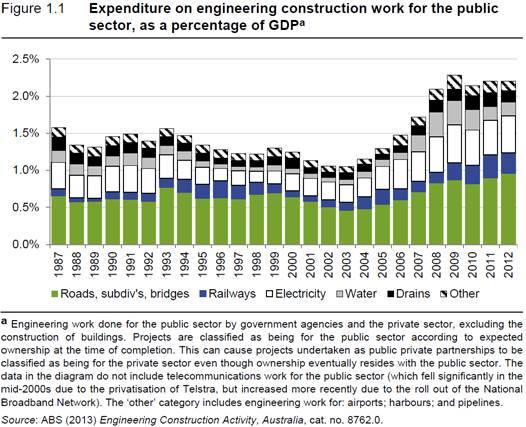The great infrastructure drain must be plugged
Australia’s public infrastructure has eroded across a variety of areas in recent decades, but is more investment really the answer? Before governments go on a spending spree, they might want to take on board the recommendations of the Productivity Commission to ensure they are not simply wasting taxpayers’ money.
The Productivity Commission, in a draft report on public infrastructure, has declared the need for a “comprehensive overhaul of the processes in the assessment and development of public infrastructure projects”. In a damning assessment it cited “numerous examples of poor value-for-money” projects due to inadequate project selection and warned that without reform, “more spending will simply increase the cost to users, taxpayers, [and] the community.”
Australia has suffered from a public infrastructure shortfall for decades now, as successive governments at all levels have wasted a once-in-a-lifetime opportunity to fund infrastructure, boost productivity and set Australia up for the future. Instead Australia finds itself on the back-end of a mining boom, with a structural budget deficit that is set to deteriorate further and a backlog of necessary infrastructure investment that would make your head spin.
The value of public infrastructure varies significantly across the community and across industries but is integral to a well-functioning economy. Transport infrastructure connects businesses with customers and employees, electricity and energy infrastructure allows businesses and households to operate, while infrastructure in schools and hospitals improves human capital among many other social benefits.
The entire stock of public infrastructure, operating collectively, promotes productivity and growth and forms the building blocks of Australia’s economy. A failure to invest sufficiently erodes those benefits, weighing on growth, living standards and productivity.
The Productivity Commission report comes just months after Reserve Bank of Australia Deputy Governor Philip Lowe emphasised the importance of infrastructure investment as a method to boost productivity growth (Get smart or face infrastructure chaos, November 26). With the effects of the mining boom diminishing and the population ageing, Lowe correctly recognises that higher productivity growth will be necessary if we wish to maintain the type of growth that Australians have come to take for granted.
The level of infrastructure spending has risen significantly over the past six years, partly driven by the onset of the global financial crisis, but more spending does not necessarily equal better outcomes. Choosing the right project is far more important than simply throwing darts and hoping that some of them work out.

The Productivity Commission makes it clear that Australian governments, at all levels, have not got the balance right.
For example, the National Broadband Network proceeded without a cost-benefit analysis, focusing too much on “how best to implement the government’s policy objectives” and failing to analyse the macroeconomic and social benefits arising from the implementation of a high-speed broadband network.
Of course the rot wasn’t just at the federal level. The Productivity Commission identified desalination plants and electricity networks as examples of inefficient state projects where processes could be improved. The reality is that there were very few projects not plagued by inefficiencies and questionable decision-making.
The Productivity Commission recommend immediate reform and a comprehensive overhaul to how governments assess and develop infrastructure projects. Naturally, undertaking a rigorous cost-benefit analysis for infrastructure proposals is an important first step.
But there also must be consideration on how best to fund projects. The Productivity Commission recommends user charges be utilised as often as is justifiable. In addition, private sector involvement should be undertaken to the extent that it is implemented well – whether private or public funded, inefficient construction will cost users or taxpayers significantly.
The cost of infrastructure projects has ballooned over the past decade. Most of this is due to construction costs rather than labour costs. Most parties surveyed “did not raise IR [industrial relations] as a major source of cost pressures.” But the take home point is that in an increasingly costly environment getting the selection process right has never been more important.
Some readers will be concerned about financing new public infrastructure projects. Don’t we have a budget emergency? It is important to distinguish between a short-term and long-term budget emergency.
Former Australian Treasury secretary Ken Henry was absolutely correct to question the long-term sustainability of the federal budget (Henry and the tax experts are wasting their breaths, March 12). However, in the near term we could invest significantly in public infrastructure without compromising the budget’s long-term sustainability. There is absolutely nothing wrong with borrowing to fund long-term, profitable projects.
Historically low interest rates have provided an unprecedented opportunity for Australia – and much of the developed world – to pursue much-needed infrastructure projects. That we have largely failed to pursue an ambitious investment agenda – and failed to select and develop the best projects when we have – is deeply disappointing and will have economic reverberations for decades to come.
Public infrastructure is important; it forms the very building blocks that allow the economy to function. But it is clear that governments, at all levels and of both persuasions, have failed to get the balance right between funding necessary infrastructure, pursuing political objects and selecting the best projects.
With the effects of the mining boom diminishing and the population ageing, higher productivity growth will be necessary to maintain the type of growth that Australians have become accustomed to. Public infrastructure will be a necessary component to that but the system needs desperate improvement by removing political ideology and simply focusing on the costs and benefits that each project can provide to the Australian economy.













